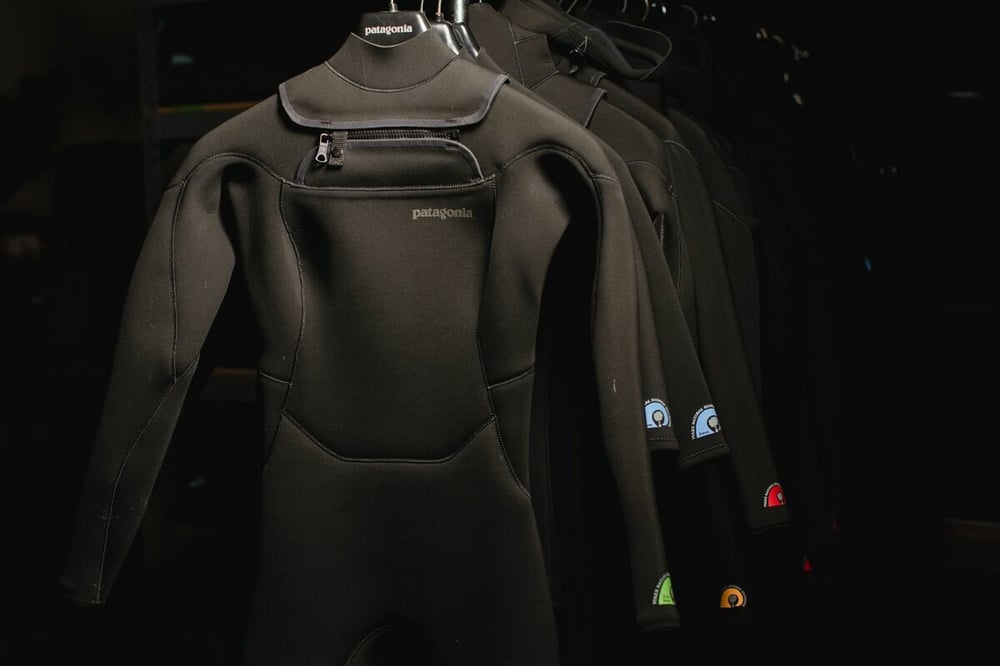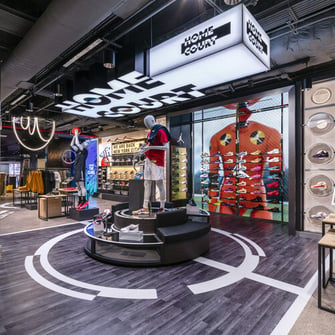Bloomberg
May 2, 2024
Patagonia is cracking the code on endlessly recyclable wetsuits
Bloomberg
May 2, 2024
Starting next year, Patagonia’s wetsuits won’t just be recycled — they’ll be reincarnated.
At the company’s “Wetsuit Forge” repair and design center, located a few blocks from the beach in Ventura, California, a first-of-its-kind wetsuit is draped over a table. The suit looks and feels like any other, but it’s made in part from used Patagonia wetsuits broken down at a molecular level. It too will be melted down at the end of its life and reborn into a new, lower-carbon wetsuit.

The prototype is the product of a years-long initiative by Patagonia Inc. to eliminate much of the waste that accumulates when a surfer buys a new wetsuit. While the outdoor apparel retailer guarantees a lifetime of repairs for wear and tear, eventually the day comes when the racks of old wetsuits awaiting mending in Ventura can no longer be stitched back together. Some are recycled into yoga mats or tote bags, but inevitably, they all end up buried in landfills.
Just how many old Patagonia wetsuits end up as part of $500 reincarnated versions depends on the volume of discarded wetsuits the company collects. But the strategy is ushering in a potentially repeating cycle that would yield the ultimate, immortal wetsuit.
“Essentially, a wetsuit becomes endlessly reusable,” says Mackenzie Warner, a Patagonia material developer.
The $2 billion wetsuit market is the antithesis of fast fashion, the cheap disposable clothes largely responsible for the apparel industry’s growing carbon footprint. Surfers tend not to be slaves to style, at least when it comes to wetsuits, often only buying an expensive new one when their old one wears out. Roughly 7 million wetsuits are sold annually and the global market is forecast to grow to $3.5 billion by 2033.
Patagonia in particular has built eco-consciousness into a billion-dollar brand by making clothes for hiking, climbing and surfing out of pricey but sustainable materials, then urging its customers to wear the gear until it frays before returning it for repair or resale. The company sells about 100,000 wetsuits a year.
“Durability and reparability affect environmental impact,” says Veronica Bates Kassatly, a London-based fashion industry analyst focused on sustainability. She cites the example of wearing a shirt 500 times. If a cheaply made shirt is replaced after being worn 10 times, 50 shirts will need to be produced and discarded. But if one better-made and easily mended shirt can be worn 500 times, the environmental cost is significantly lower, even if making the garment uses more water and energy upfront.
Despite surfing’s one-with-nature vibe, most wetsuits are the sartorial equivalent of an oil spill. They’re made from neoprene, a petroleum-based synthetic rubber. (Many wetsuits sold in California even carry a state warning that they can expose you to chemicals known to cause cancer.) Patagonia is collecting end-of-life wetsuits for a partner that vaporizes them to reclaim what’s known as carbon black, a key ingredient in neoprene and in the natural rubber Patagonia uses. It’s the petroleum-derived element that gives wetsuits their strength and jet-black color.
Whether carbon black can be infinitely recovered remains to be scientifically validated, but reusing it keeps old wetsuits out of landfills. The reclaimed material also avoids carbon dioxide emissions from the production of virgin carbon black, a ubiquitous ingredient in tires, plastics, inks and electronics. The material’s $19.3 billion market, which is expected to grow 66% by 2032, emits as much as 79 million metric tons of CO2 annually from the combustion of tar oil and other petroleum feedstocks, according to a January paper published in the Journal of Cleaner Production.
“Circularity is always the good approach,” says Fabian Rosner, lead author of the paper and an assistant professor of civil and environmental engineering at the University of California at Los Angeles. “If you can reclaim that carbon black, you reduce the amount of resources that you need in the first place.”
About a decade ago, Patagonia began to replace neoprene with Yulex, the brand name for a natural rubber produced by drought-resistant Hevea trees and Guayule plants grown on non-arable land. The company’s latest wetsuit line, released in September, is 85% Yulex, and rival surf brands have also started to add Yulex and other sustainable materials to their wetsuits. Some have also launched recycling initiatives.
But even Yulex wetsuits are made with carbon black. That led an entrepreneur named Tony Wibbeler to show up at Patagonia’s door in 2017 with a pitch for a sustainable solution to both the carbon black conundrum and the recycling challenge.
The startup Wibbeler founded, Boulder, Colorado-based Bolder Industries, developed an industrial process to reclaim carbon black from old tires, which it sells as BolderBlack. He told Patagonia executives he could create a proprietary formula to do the same for their wetsuits. Wibbeler says Bolder’s method is 85% more sustainable than traditional carbon black production.
Rosner says the CO2 savings from reclaimed carbon black depend on the energy efficiency of the reclamation process. But the environmental impact could be substantial: Carbon black accounts for about 20% of Patagonia wetsuits’ rubber foam and is also used to dye the wetsuits’ recycled nylon lining, according to Hub Hubbard, the company’s product line manager for surf and wetsuits.
At the Wetsuit Forge, Warner points to a container full of inky granules of BolderBlack. “It was kind of a no-brainer for us to switch to BolderBlack as it has a pretty wide impact on the overall wetsuit,” she says.
Bolder isn’t the only company producing reclaimed carbon black for wetsuits. Taiwan-based Sheico, which manufactures wetsuits for Patagonia and other major surf brands, has started using its own reclaimed carbon black from old tires. Patagonia is the first, though, to source the reclaimed material from used wetsuits. The company will collect end-of-life wetsuits, remove the zippers and ship them to Bolder to extract the carbon black. The reclaimed material will then be sent to Patagonia’s manufacturer.
“It’s a circular solution, not just a sustainably sourced or a bio-based material,” says Wibbeler, who is also Bolder’s chief executive officer. “The cool part about this is that it’s wetsuits to wetsuits.”
The first BolderBlack Patagonia wetsuits are set to go on sale in 2025. Bolder will mix old wetsuits with tires so enough BolderBlack is produced for each reincarnated suit.
In the meantime, the company continues to improve its wetsuits’ durability and repairability. The Wetsuit Forge opened in 2020 as the Covid-19 pandemic inspired a new wave of sustainably minded surfers to take up the sport after gyms shuttered. As supply chain snarls led to a shortage in new wetsuits, a tsunami of used ones arrived in Ventura for repair — some 6,000 over the past three years. The pandemic also closed down recycling programs, spurring an effort to prolong the lives of wetsuits and close the loop on reuse.
“When we get all these suits that come through the door, we're really able to pinpoint where the failure was on the suit and track those data points for each generation of suit,” says Patagonia wetsuit engineer Buddy Pendergast. “We started drawing those hard correlations between repeat failures that we wanted to address.”
To illustrate his point, Pendergast walks over to a table and picks up a wetsuit to show how a seam has been replaced with one that’s more durable and quicker to repair. When the data indicated that ankle cuffs were commonly failing, the team redesigned that part of the wetsuit, too. A rack of surfboards stands along one wall of the Forge so engineers can test design tweaks at C Street, a legendary surf break nearby. All of the engineers’ learnings and upgrades have been incorporated into the reincarnated wetsuit.
“We lab tested it, we field tested it and made sure that it would pass all of our quality standards,” Warner says.
The fast-fashion dynamic has made it so that people often find it “cheaper and easier to buy a new item than to repair an existing item,” says Kassatly, the fashion analyst. Patagonia has already flipped that calculation. Pendergast says the company has a 90% repair rate; for just the cost of shipping most times, a surfer gets an improved wetsuit without buying a new one. But the success of the BolderBlack initiative will depend on getting surfers to send their beyond-repair wetsuits back to Patagonia a final time — at least in their current life — rather than letting them molder in the garage.
“Our hope is that once this gets out, people are going to start digging out all their old wetsuits to send to us,” says Hubbard.
Copyright Bloomberg












